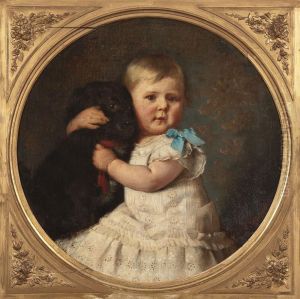Gustav Bregenzer Paintings
Gustav Bregenzer was a German-born artist whose work spanned the late 19th and early 20th centuries, a period marked by significant transformations in the world of art. Born in 1863, Bregenzer's early life and education were deeply rooted in the rich cultural and artistic heritage of Germany, a country that was experiencing its own form of the modernist revolution. Though not as widely recognized as some of his contemporaries, Bregenzer's contributions to the art world during his time were nonetheless significant, reflecting the broader movements of symbolism and expressionism that were prevalent in European art during his lifetime.
Bregenzer's work is characterized by a deep exploration of the human condition, often focusing on themes of emotion, spirituality, and the natural world. His artistic journey began in the traditional academic setting, where he honed his skills in drawing and painting, but he quickly evolved to develop a unique style that sought to go beyond the visible world. By the turn of the century, Bregenzer had begun to experiment with more abstract forms and techniques, influenced by the burgeoning expressionist movement in Germany and beyond. His paintings from this period are noted for their vibrant use of color, dynamic compositions, and the emotional depth they convey.
As the 20th century progressed, Bregenzer continued to evolve his artistic approach, adapting to the changing times while maintaining a strong personal voice. He was not just a painter; his body of work also included sculpture and printmaking, showcasing his versatility as an artist. Despite the challenges posed by two World Wars and the shifting landscape of the art world, Bregenzer remained committed to his craft, exploring new ideas and techniques until his death in 1950.
While Gustav Bregenzer may not have achieved the same level of fame as some of his contemporaries, his work has been recognized for its contribution to the development of modern art in Germany. His exploration of expressionism and symbolism, combined with a distinctive use of color and form, make his work a valuable part of the artistic canon of his time. Today, Bregenzer's art is appreciated by a growing number of collectors and scholars, who recognize in his paintings a poignant reflection of the human experience, marked by a deep sensitivity to the spiritual and emotional landscapes of his era.








